click on images to enlarge
The art of the Table: an Art of life
'It was once... silverware'
Today, when you'll take in hand this utensile with a customary
gesture, I suggest to look with admiration to these extensions
of your fingers you are accustomed to handle with grace and
skillfullness since your childhood. These objects looks so
anonymous as they are so functional; their shape is adapted to
your hands, their decorative research or their clean design
reflects the refinement of table practices and the evolution of
our customs.
Despite our restless modern way of life take the time to breathe,
enjoy the scent of their presence and the flavour of history and
'small history' of the silverware that illuminates and
adorns your table.
I've choosen to begin this article as a fairy tale as, along
with silverware's history, I have in the mind the tale of the
'Sleeping Beauty' where her godmother offers to the guests
precious metal silverware. Today, the godmother gifts yearly
silverware to her godchild in order to complete the table set.
What was the origin of this custom?
History, and moreover folklore, use these elements of the 'Art
of the Table' to illustrate the customs and the evolution of
silverware.
But what is the meaning of 'silverware'? Its composition,
as we know it today - a set of spoon and fork of similar shape
and decoration - was introduced in the last quarter of the 17th
century. The French word for silverware is 'couvert'. In
Italian it is 'posate'.
They have a similar origin from the usage in the Middle Ages to
'cover the table', that is to place on it all that is
necessary to the meal (glasses, salts, dishes, etc. ..).
Progressively, the term was used to identify the set of spoon
and fork.
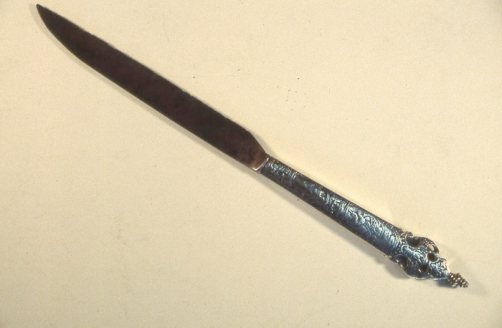
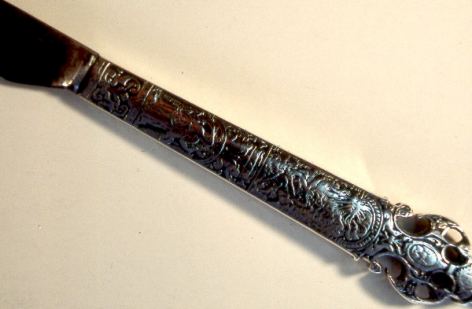 The usage of the knife develops since the 12th
century. It was an item of personal usage made by a
craftsman (the 'cutler maker'). The knife was worn on
the belt in a leather sheath and, in a hygiene concern,
the guests used their private knife on the host table. .
The usage of the knife develops since the 12th
century. It was an item of personal usage made by a
craftsman (the 'cutler maker'). The knife was worn on
the belt in a leather sheath and, in a hygiene concern,
the guests used their private knife on the host table. .
photo 2a photo 2b
|
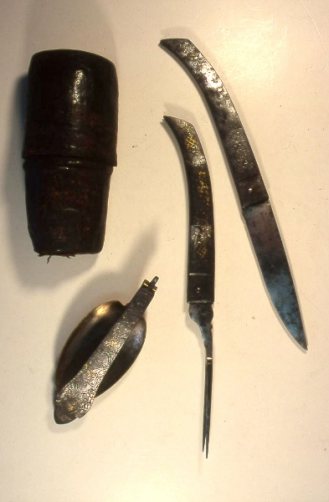
The ancient knife was very flaked and pointed, and
was used both to prick the meat in the dishes and to cut
it on the trencher.
photo 4
|
On the 17th century they rounded their tip and the owners
ceased to use the knives during the meal as toothpicks or as
weapons against their rivals!
In the 13th century, the fork was a two-pronged device used to
transfer the meal from the pot to the dish (not to carry the
meal to the mouth)
The usage of the fork, as we currently know, spread in Italy
during the Renaissance, when in the Italian Courts began the use
of the fork to carry the food to their mouth, avoiding soiling
the clothes and hands.
This use of the fork, as a symbol of pretentious display, became
a source of satire in the court of Henry III.
Two-pronged at first, the fork was modified to three-pronged and
then to four-pronged at the end of the 17th century.
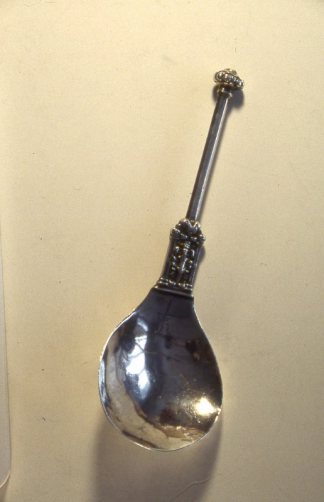
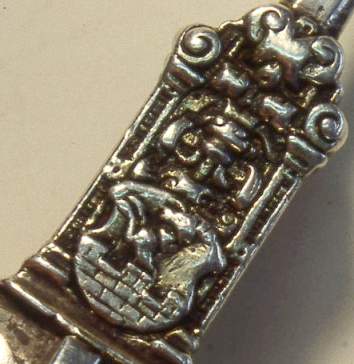
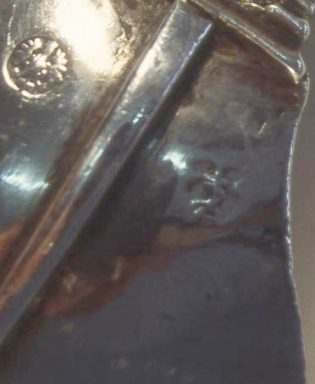 Before the Renaissance it was a good custom in Europe
to eat using the fingers and to wash the hands at every
course with perfumed water poured by servants into a
basin from a silver pitcher. This was a custom
reflecting the taste for cleanliness and hygiene of its
era (see endnote).
Before the Renaissance it was a good custom in Europe
to eat using the fingers and to wash the hands at every
course with perfumed water poured by servants into a
basin from a silver pitcher. This was a custom
reflecting the taste for cleanliness and hygiene of its
era (see endnote).
photos 1a, 1b, 1c
|
King Louis XIV forbade the tutor of his children to learn
eating with the fork, as this usage had negative connotations
(scarcity of hygiene and proof of improper manners)
The spoon was used since the dawn of time to carry liquid
foods to the mouth.
You may imagine the difficulty that our ancestors had in the
usage of this 'appendix'. Fortunately deepening the bowl and
sharpening its shape, they learned to use it.
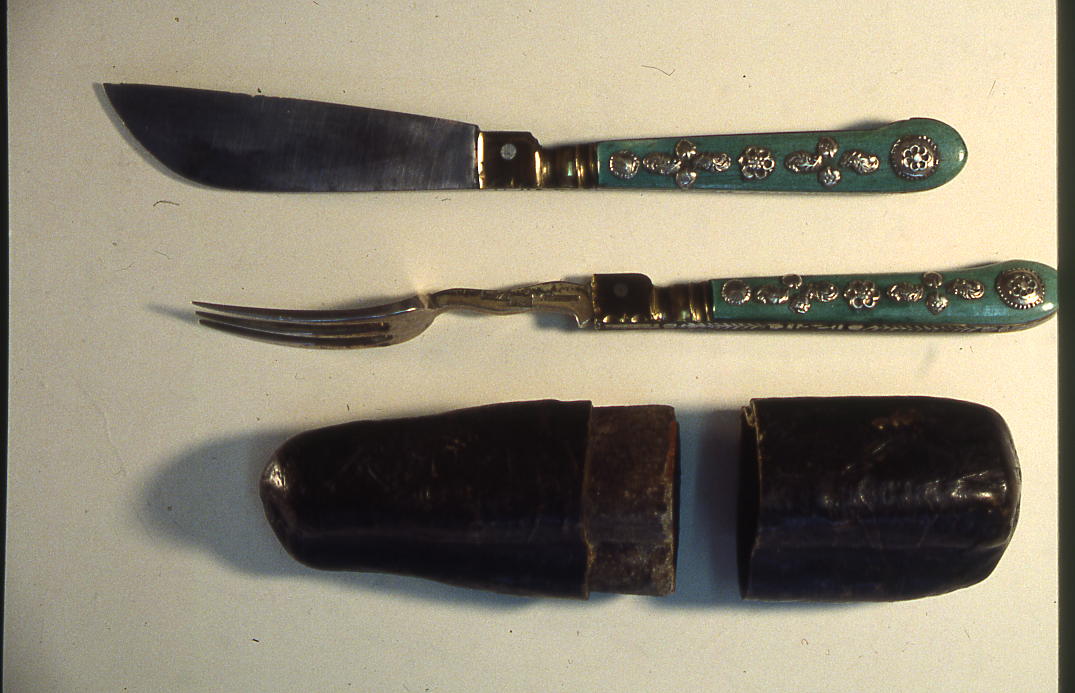 In the 17th century the guests used for the meal the
silverware they brought with them. This is the origin of
the so-called 'travel set' composed of a folding fork
and an adaptable spoon into a proper case.
In the 17th century the guests used for the meal the
silverware they brought with them. This is the origin of
the so-called 'travel set' composed of a folding fork
and an adaptable spoon into a proper case.
photo 5
|
Everyone had his private silverware, precious and decorated
according to the social condition, the culture and the wealth of
its owner. A silverware set was also a traditional wedding gift.
Later, silverware was supplied by the host to his guests and
sets of six and twelve pieces became available.
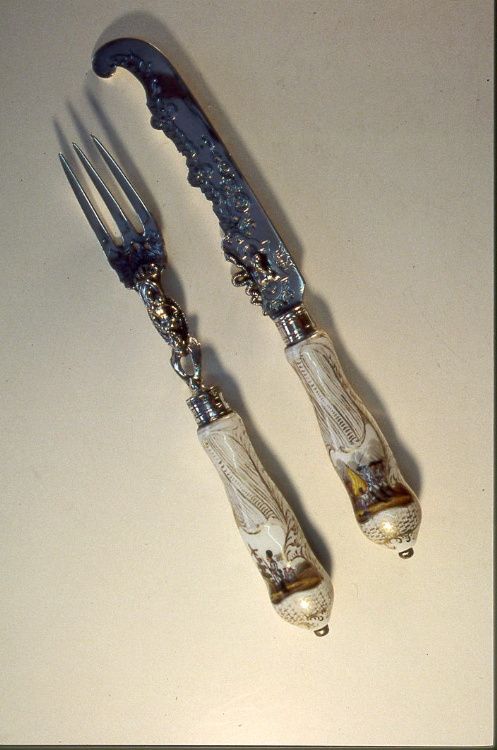
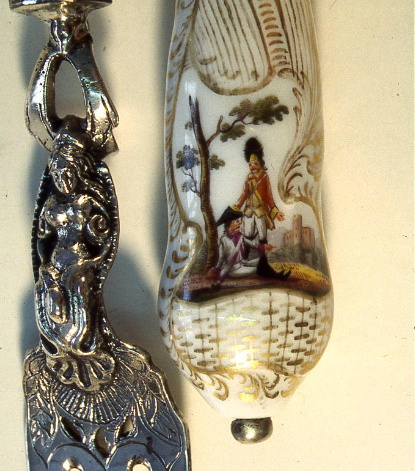 The knives were made by the cutler and often had a
different shape from spoon and fork.
The knives were made by the cutler and often had a
different shape from spoon and fork.
photo 8a et 8b
|
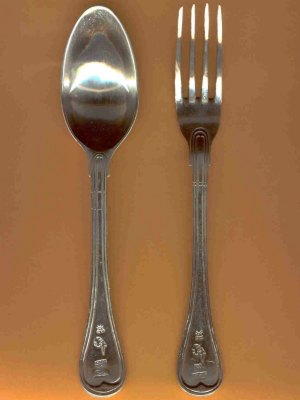
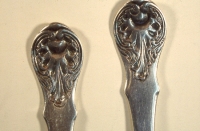 The silverware of the 18th century has a variety of
shapes, from plain to highly elaborate rococo. At the
end of the 17th-beginning of the 18th century the spoon
was reinforced by the 'rat tail' and the 'dessert
silverware' was added to the table (often gilt to
prevent oxidation by fruit's acids).
The silverware of the 18th century has a variety of
shapes, from plain to highly elaborate rococo. At the
end of the 17th-beginning of the 18th century the spoon
was reinforced by the 'rat tail' and the 'dessert
silverware' was added to the table (often gilt to
prevent oxidation by fruit's acids).
photo 9 photo 7
|
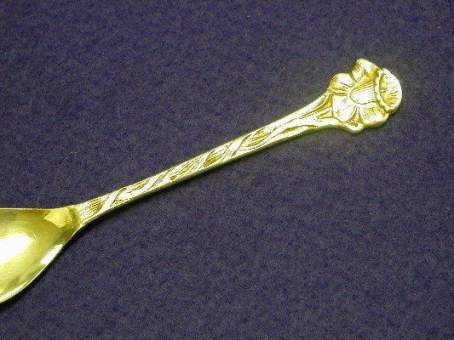
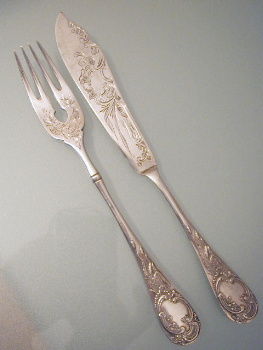 Up to the middle of the 19th century silverware were
made by craftsman. The introduction of mechanical
processes made available these items to a wider public.
The first 'fish silverware' appears in the second half
of the 19th century, when different and more
'specialized' sets of silverware were introduced
Up to the middle of the 19th century silverware were
made by craftsman. The introduction of mechanical
processes made available these items to a wider public.
The first 'fish silverware' appears in the second half
of the 19th century, when different and more
'specialized' sets of silverware were introduced
photo 10 photo 11
|
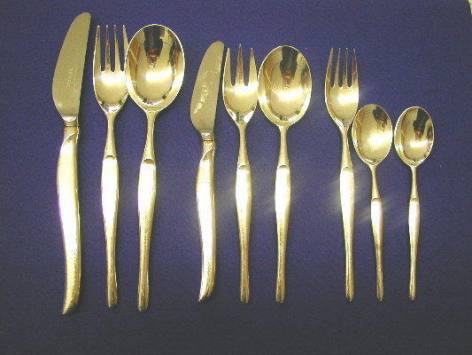 But, fortunately, the evolution and the aesthetic
research continues also in the 20th century and in the
'mechanisation era'.
But, fortunately, the evolution and the aesthetic
research continues also in the 20th century and in the
'mechanisation era'.
Reacting to the general uniformity of the period, the
famous Belgian 'art nouveau' artist Henry Van de Velde
created simple and highly functional silverware, where
the originality of the design was the ergonomic
adaptation of every element to its usage.
Surprisingly, the Art Déco production, concerned to
adopt geometric shapes, produced silverware not easy to
handle (spoons too plain, forks unsuitable for their
usage).
photo 12
|
Martine D'Haeseleer
Expert et enseignante en orfèvrerie ancienne et moderne belge
et européenne.
Fondatrice de la Silver Society of Belgium.
Créatrice du site : www.silverbel.org
Bibliography:
'Couverts de l'art gothique à l'art nouveau' - Collection
Jacques Hollander.
'Alte Bestecke' - Collection Callway - by Gertrude Benker.
'Bestecke' -Die Eglofstein'sche Samlung “ 15 - 18 Jahrhunderd
auf der Wartburg'
Edition: Arnoldsche.
Musée du couvert : Musée Mandet à Riom - France
Description of photos : (Copyright Martine D'Haeseleer)
except n° 9 (© Munozarce)
photo 1
Wedding spoon of the Renaissance ( 16th century)
Frankfürt - Germany.
Dimension:14,5cm
Collection : Bernard.De.Leye.
photo 2a 2b
Silver wedding knife with steel blade (2nd half of the 17th
century)
Origin: Low-Countries or Anvers (dimension: 18,5 cm)
Handle engraved on a black background with scenes in the manner
of Jean-Théodore de Bary, ( cfr. Zilver uit de Gouden Eeuw van
Antwerpen)
Collection: Bernard De Leye.
photo 4
Folding travel silverware on iron with gold and silver
applications
Karlsbad 17th century
Spoon, fork and knife in a leather case
Collection : D.P.
photo 5
Folding travel silverware, ivory handle (dyed in green) with
silver applications
Origin: Italy, end of the 17th century.
Restored in Russia in 1853 replacing the silver fork
Collection : 'Magazin Royal'
Collection : D.P.
photo 7
Detail of a table silverware with shell in relief
Origin : Oudenaerde 1767, M.O.: 'à la Flèche'
Collection : Dominique van Haecke.
photo 8a 8b
table silverware in silver and Meissen porcelain
Origin: Germany, about 1770.
Blade and fork with female figures in relief, handles with
military scenes
Collection : 'Magazin Royal'
photo 9
Detail of the floral decoration of an 'Art Nouveau' coffee spoon
of the beginning of 20th century. Likely Spain
Provenance: 'Munozarce' Madrid.
photo 10
Detail of the floral decoration of an 'Art Nouveau' coffee spoon
of the beginning of 20th century. Likely Belgium
photo 11
Fish silverware, silversmith Delheid Frères - Bruxelles about
1890-1900. Chiselled model in pre-Art Nouveau style
photo 12
gilt silverplate silverware, 'DUO' model, designed in 1957 by
'Tapio Wirkkala' (Formes Nouvelles collection of Maison
Christofle, France)
Collection : F.Van de Rose
My thanks for their precious help to the friends who
collaborated to illustrate this article
- Martine D'Haeseleer -
English text by Giorgio Busetto and Douglas Hawkes
endnote
(by Giorgio Busetto)
The use of the forks at table does not seem to have been
generally introduced in England until after the Restoration, and
the experienced traveller Fynes Morison (1617)
'observed a custom in all those Italian cities and towns
through which I passed that is not used in any other country
that I saw in my travels, neither do I think that any other
nation of Christendom doth use it, but only Italy. The Italians,
and also most strangers that are commorant in Italy do always at
their meal use a little fork when they eat meat... their forks
being for the most part of iron or steel, and some of silver,
but those were used only by gentlemen. The reason for this their
curiosity is because the Italians cannot endure by any means to
have his dish touched by fingers, seing that all men's fingers
are not alike clean'
(from: 'Silver' by Gerald Taylor, Penguin Books 1963, page
127)
|
 ASSOCIATION OF SMALL COLLECTORS OF ANTIQUE SILVER
ASSOCIATION OF SMALL COLLECTORS OF ANTIQUE SILVER ASSOCIATION OF SMALL COLLECTORS OF ANTIQUE SILVER
ASSOCIATION OF SMALL COLLECTORS OF ANTIQUE SILVER